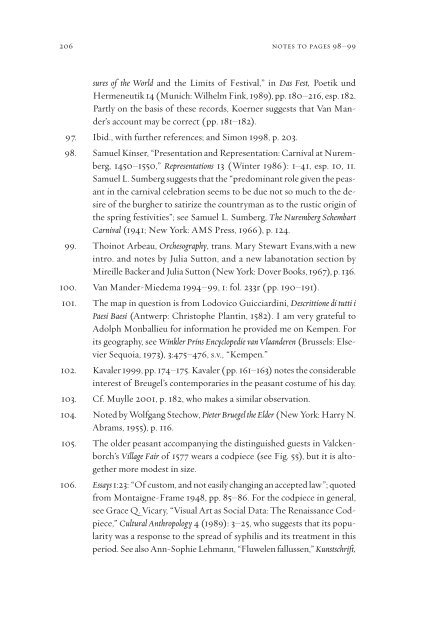Pieter Bruegel and the Art of Laughter - AAAARG.ORG
Pieter Bruegel and the Art of Laughter - AAAARG.ORG
Pieter Bruegel and the Art of Laughter - AAAARG.ORG
Create successful ePaper yourself
Turn your PDF publications into a flip-book with our unique Google optimized e-Paper software.
206 notes to pages 98–99<br />
sures <strong>of</strong> <strong>the</strong> World <strong>and</strong> <strong>the</strong> Limits <strong>of</strong> Festival,” in Das Fest, Poetik und<br />
Hermeneutik 14 (Munich: Wilhelm Fink, 1989), pp. 180–216, esp. 182.<br />
Partly on <strong>the</strong> basis <strong>of</strong> <strong>the</strong>se records, Koerner suggests that Van M<strong>and</strong>er’s<br />
account may be correct ( pp. 181–182).<br />
97. Ibid., with fur<strong>the</strong>r references; <strong>and</strong> Simon 1998, p. 203.<br />
98. Samuel Kinser, “Presentation <strong>and</strong> Representation: Carnival at Nuremberg,<br />
1450–1550,” Representations 13 (Winter 1986 ): 1–41, esp. 10, 11.<br />
Samuel L. Sumberg suggests that <strong>the</strong> “predominant role given <strong>the</strong> peasant<br />
in <strong>the</strong> carnival celebration seems to be due not so much to <strong>the</strong> desire<br />
<strong>of</strong> <strong>the</strong> burgher to satirize <strong>the</strong> countryman as to <strong>the</strong> rustic origin <strong>of</strong><br />
<strong>the</strong> spring festivities”; see Samuel L. Sumberg, The Nuremberg Schembart<br />
Carnival (1941; New York: AMS Press, 1966 ), p. 124.<br />
99. Thoinot Arbeau, Orchesography, trans. Mary Stewart Evans,with a new<br />
intro. <strong>and</strong> notes by Julia Sutton, <strong>and</strong> a new labanotation section by<br />
Mireille Backer <strong>and</strong> Julia Sutton (New York: Dover Books, 1967), p. 136.<br />
100. Van M<strong>and</strong>er-Miedema 1994–99, 1: fol. 233r ( pp. 190–191).<br />
101. The map in question is from Lodovico Guicciardini, Descrittione di tutti i<br />
Paesi Baesi (Antwerp: Christophe Plantin, 1582). I am very grateful to<br />
Adolph Monballieu for information he provided me on Kempen. For<br />
its geography, see Winkler Prins Encyclopedie van Vla<strong>and</strong>eren (Brussels: Elsevier<br />
Sequoia, 1973), 3:475–476, s.v., “Kempen.”<br />
102. Kavaler 1999, pp. 174–175. Kavaler (pp. 161–163) notes <strong>the</strong> considerable<br />
interest <strong>of</strong> Breugel’s contemporaries in <strong>the</strong> peasant costume <strong>of</strong> his day.<br />
103. Cf. Muylle 2001, p. 182, who makes a similar observation.<br />
104. Noted by Wolfgang Stechow, <strong>Pieter</strong> <strong>Bruegel</strong> <strong>the</strong> Elder (New York: Harry N.<br />
Abrams, 1955), p. 116.<br />
105. The older peasant accompanying <strong>the</strong> distinguished guests in Valckenborch’s<br />
Village Fair <strong>of</strong> 1577 wears a codpiece (see Fig. 55), but it is altoge<strong>the</strong>r<br />
more modest in size.<br />
106. Essays 1:23: “Of custom, <strong>and</strong> not easily changing an accepted law”; quoted<br />
from Montaigne-Frame 1948, pp. 85–86. For <strong>the</strong> codpiece in general,<br />
see Grace Q. Vicary, “Visual <strong>Art</strong> as Social Data: The Renaissance Codpiece,”<br />
Cultural Anthropology 4 (1989): 3–25, who suggests that its popularity<br />
was a response to <strong>the</strong> spread <strong>of</strong> syphilis <strong>and</strong> its treatment in this<br />
period. See also Ann-Sophie Lehmann, “Fluwelen fallussen,” Kunstschrift,












